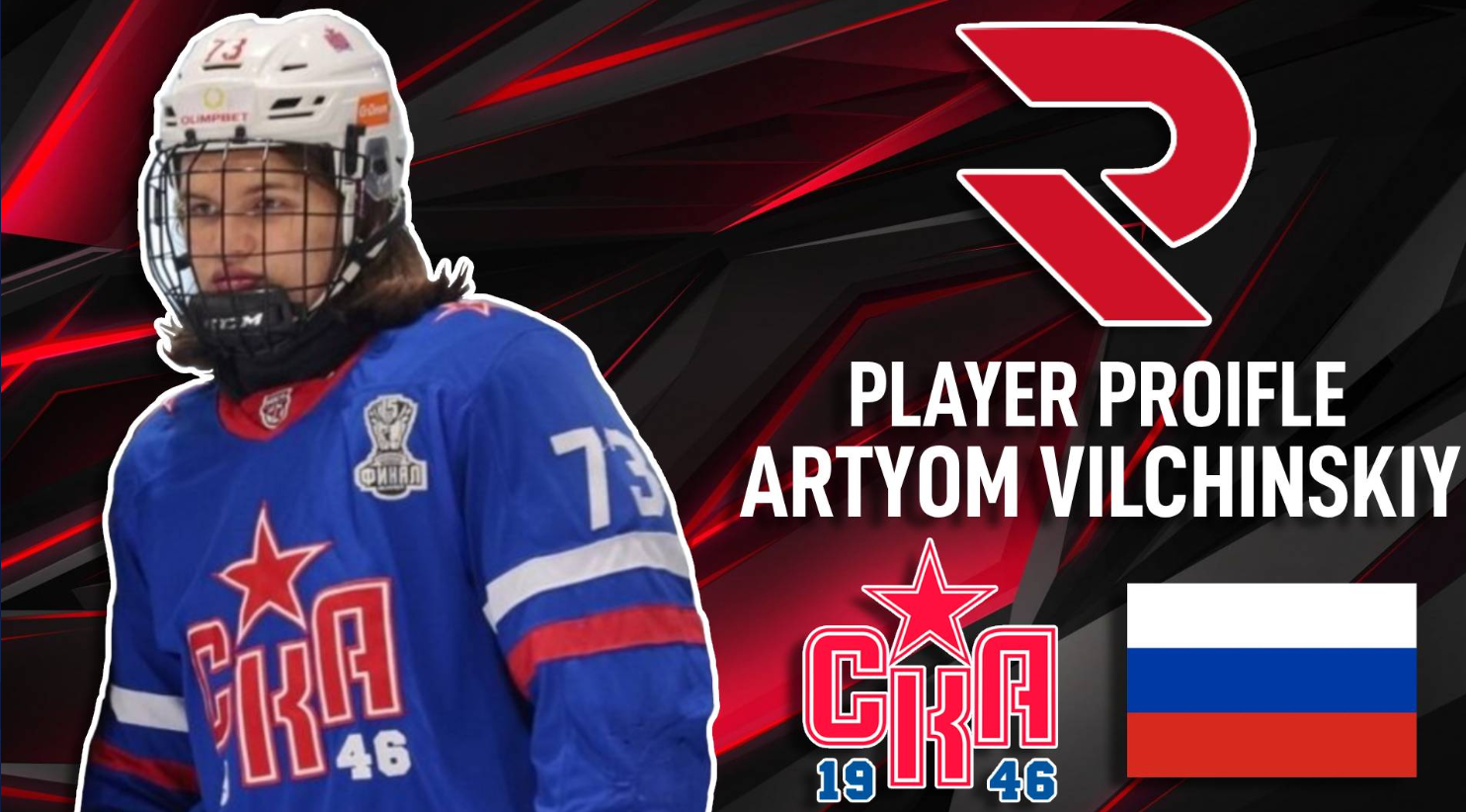After Dmitry Simachev (#6 OA 2023) and Anton Silayev (#10 OA 2024), fans are wondering if Artyom Vilchinsky could be the next large-framed Russian defenseman to rise through the rankings.
At 6’6″ and 240 lbs, Artyom Vilchinsky certainly possesses qualities that are highly coveted by NHL front offices. However, I’m not yet ready to place him in the same category as his two fellow countrymen mentioned earlier.
Here’s how his game breaks down:
Team: SKA-1946 St. Petersburg (MHL)
Date of Birth: September 16, 2006
Height: 197 cm / 6’6″
Weight: 109 kg / 240 lbs
Position: D
Handedness: Left
Skating
I’ll start with the overused phrase, “he skates well for a guy his size.” In this case, it’s actually true. His forward speed is quite impressive. While he doesn’t extend his stride enough, he transfers his body weight well and is able to generate power with shorter strides.
His lateral mobility seems to have improved compared to what I saw in him last year. However, his pivots are still a bit slow, which can be an issue when opposing players dump the puck behind him. Overall, his skating has room for improvement and could eventually become a real asset. For now, though, he can keep up with most forwards and wins the majority of foot races to loose pucks.
Defensive Play
Artyom Vilchinsky excels against the rush. He uses his long stick and maintains good gap control. When within range, he disrupts the play with his stick and steps up quickly, pushing players along the wall at the blue line, sometimes resulting in a solid hit. He reacts quickly and has good hand-eye coordination to gain control of pucks — something that can be more challenging for bigger prospects. He’s very difficult to beat one-on-one; your best bet is to put the puck behind him.
In the defensive zone, he doesn’t fall into the common trap of bigger defensemen who try to clear the front of the net at all costs, ignoring the rest of the play. His game is far from perfect, though. He has a tendency to get drawn out of position and baited out of coverage, becoming reactive rather than proactive in the defensive zone.
One of Vilchinsky’s strengths is definitely his board play. His physicality, which will be discussed in the next section, plays a big role in this. Chances are, he will overpower his opponent, even if his positioning isn’t perfect.
Here, you can see an example of Vilchinsky recognizing a bad touch, stepping up to break the play, and following it up with a heads-up play up the ice.
Physicality
When you watch Vilchinsky, the first thing that stands out is his size. At 6’6″, the defenseman towers over most of his competition in the MHL. But it’s not just his appearance—he effectively uses his strength to take players out of the play and free up pucks.
He enjoys delivering hits but doesn’t overdo it. At times, it feels like he doesn’t even need momentum to send players flying.
In puck-possession situations, he easily brushes off opponents and holds onto the puck using sheer strength. At his current level of competition, it’s nearly impossible for players to strip the puck away from him.
Offensive Upside
In transition, the big Russian mostly makes good decisions, showing strong scanning habits. He’s not the most creative in his decision-making but tends to choose his first read option. I’ve seen games where he struggled with execution and others where he delivered crisp passes on exits.
When he sees space and the play is in front of him, Vilchinsky loves to take off with the puck and carry it into the opposing zone. However, when he does, he often skates into pressure, trying to force his way through the middle of the ice. His puck protection, combined with his speed and problem-solving stickhandling, allows him to move up the ice effectively.
Here’s an example of Artyom Vilchinsky demonstrating puck protection and maneuvering through the neutral zone. He then skates into pressure, as he often does in that situation.
His offensive zone play is where I see most of his limitations. Almost all of his offensive-zone puck touches end up being shots, many of which are in clogged lanes. There’s little creativity or playmaking in this phase of his game. He tends to stay back but will aggressively pinch to prevent zone exits when he sees an opportunity. I haven’t seen much flair for finding soft ice or a willingness to get more involved in the offensive zone play.
Conclusion
The more I watch Artyom Vilchinsky, the more I like what I see. I don’t believe he’s at the level that Simachev and Silayev were when they were drafted, but I can definitely see him being picked in the late first or early second round, based on recent NHL trends. A bit of time in the KHL would help in comparing him to his two predecessors.
Vilchinsky has the potential to develop into a strong defensive defenseman who can also contribute in transition and bring a bit of physical edge to his team.
It’s worth noting that he was born on September 16, making him one of the oldest first time draft-eligible players in his class, as he missed the cutoff by just one day.
Check back here at RecruitScouting.com for more coverage of the 2025 NHL Entry Draft as the year goes on.


